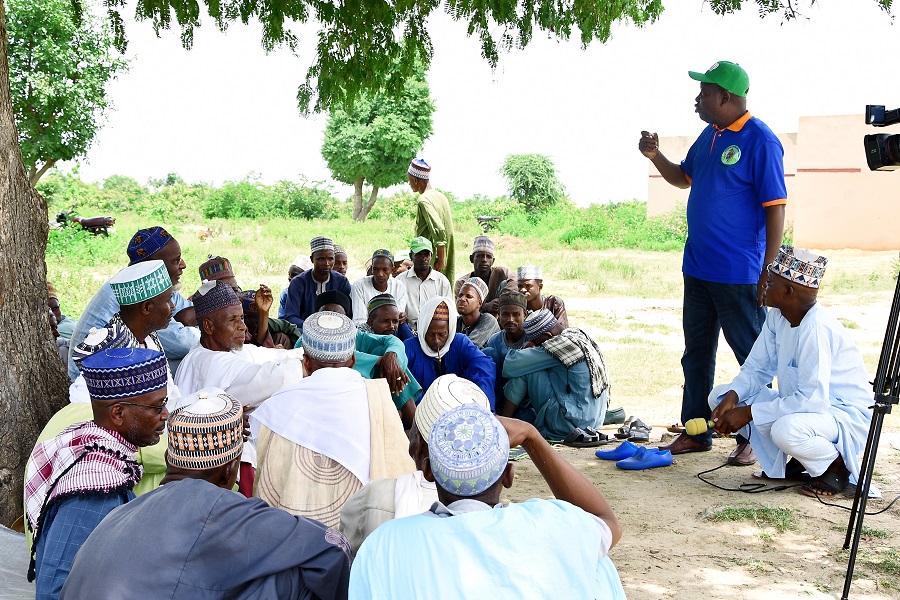In Nigeria, and particularly in Kano State, poverty, food insecurity and unemployment remain daunting challenges for policy makers and various stakeholders. Addressing these challenges and meeting the Sustainable Development Goals (SDGs) require much more efforts to enhance the nation’s economic growth on an inclusive basis. In this perspective, the Kano State Government has formulated a development strategy entitled “The Kano State Development Plan 11 2016-2025 (KSDP 11)” which aligns with the Government’s Economic Recovery and Growth Plan (ERGP) 2017-2020. The agricultural component of the KSDP 11 aim at “supporting agricultural producers, processors and market operators by promoting new agricultural technologies to increase productivity and incomes. This will reduce poverty, food insecurity and natural resource degradation. The KSDP 11 is also aligned to the Federal Government’s Agriculture Promotion Policy 2016-2020.
KSDAP will support government’s efforts to enhancing agricultural productivity and competitiveness through access to inputs and credit, value addition and market access, extension services delivery and capacity strengthening. The project will consider some relevant crosscutting issues such as private sector involvement, climate-smart agriculture, gender mainstreaming and human nutrition.

Despite the progress made in the recent past, Nigeria’s ranking on the Global Human Development Index (HDI) scale is among the lowest globally; -at 152 out of 188 territories. The National Bureau for Statistics (NBS) reported the incidence of poverty in Nigeria as 71% with 62% of the population living on less than one US dollar per day 1 (NBS 2011). The data for Kano State was 72.3% with 66% living on less than USS1 per day (NBS 2011).
Also, Kano State Ministry of Social Welfare in 2007 reported that 3.2 million out of 9 million people were living on less than $1 dollar per day. This shows the extent of the poverty in the state. The phenomenon of poverty appears to be more acute in rural than in urban areas of the country. The number of rural poor, according to the 2005 World Bank report is roughly twice than that of the urban poor, of the extremely poor, 80% lived in the rural areas and more than two-thirds lived on farms. Kano State has a poverty Index of 72.5% and population below the poverty line stands at 8 million. The unemployment rate is 26% and with 17% men and 39.5% women. A study conducted to assess the food security status among farming households in rural areas of Kano State, revealed that 26% were food insecure.
Educational level, gender, household size and access to credit were significant determiners of food security. Highest prevalence of stunting or chronic under-nutrition among children under the age of five and alarming statistics for micronutrient deficiencies of iron, vitamin A and iodine in adults and children are prevalent in food insecure situations. The insecure environment due the involvement of desperate unemployed youth in religious extremism and the threat of climate change on productive resources are further exposing the state to poverty and vulnerability.
According to Kano State Ministry of Planning and Budget, the agricultural sector’s potentials are under-utilized and its capacity to support modern economy severely constrained. The productivity is low; quality of agricultural units (including farmland, ponds, trees and livestock) is poor and private sector investments in agricultural sector not appreciable. To meet these challenges and constraints, a strong Agricultural Component has been developed in the KSDP11(2016-2025) describe above (See Country Development Strategy). The mission of this components includes “Supporting agricultural producers, processors and marketers by promoting modern (improved) agricultural technologies to increase productivity and incomes, thereby reducing poverty and enhancing food security and natural resource conservation”. The Kano State Government has made it a priority to align its KSDP 11 to the EGRP with the aim of supporting the Federal Government’s growth and recovery plans as well as stimulate investments and create income and jobs for millions of Nigerians.
To address these challenges, the KSDPII (2016-2025) considered the following as its development objectives: a fast growing and diversified economy whose development is firmly rooted in local resources; its agricultural sector shall be modernized with the capacity to ensure food sufficiency and the steady supply of raw materials to its industries; its manufacturing sector-mainly based on agriculture raw materials-shall be competitive nationally and internationally and shall hold the key to wealth creation, employment generation and poverty eradication.
These KSDP-II development objectives coincide with the third live and livelihood fund (LLF) interventions. Indeed, to save lives and strengthen livelihood, among communities, the LLF has identified 4 priority areas for intervention:
Effort targeted at controlling and even eradicating the infectious diseases which kill millions of children every year;
Improvements in basic primary healthcare, so that affordable but lifesaving treatments can be provided for everyone, especially new and expecting mothers;
Support to farmers, who make up the majority of poorest people, grow sufficient food to feed their families and sell the access to make their living and;
Giving access to the basic infrastructure, such as power, sanitation, and the basic financial systems, which can connect communities to the local and global economy;
In fact, it is from the third priority area<< support to farmers, who make of most of the Poorest people, to grow sufficient food to feed their families and sell the access to make a living.)>>, that the concept of kano state Agro-pastoral development project -KSADP is derived. The KSADP has three (3) technical components: (1) Agro-pastoral productivity and production enhancement; (2) value addition and market access; and (4) project management. Capacity building is a major cross-cutting theme within all the components.
The KSADP is developed by the Bank based on a request submitted by the Government of Nigeria. The proposed project aims at supporting the Government’s efforts to promote inclusive economic growth in Kano State. The Agro-pastoral development approach of the proposed project will target the most vulnerable, including women and youth, to promote increased agricultural production and commercialization. The theory of change of the project is to transform smallholder farming into commercially viable businesses by developing commodity value chains in order to reduce rural poverty, food insecurity, and unemployment. The project will contribute to the Government’s efforts to reduce socio-economic inter-states disparities as well as rural-urban migration. The project is consistent with the economic Recovery and Growth Plan 2017-2020 and the Kano State Development Plan 2016-2025. The project will contribute to the implementation of IDB’s MCPS, particularly Pillar 2 “Integrated Rural Development”.
The KSADP project will invest in agricultural productivity (Livestock and crops) enhancement, value addition, and market access improvement including the construction of infrastructure (rural roads, agriculture marketing centers), access to credit for smallholder farmers, and institutional capacity building for farmers and their apex associations/cooperatives as well as institutions that deliver public services to vulnerable rural farmers.
Due to effects of an increase in a human population explosion, which has resulted in the occupation of animal grazing reserves and stock routes; and climatic change, which has resulted in acute water scarcity and unending drought, dry pastures/grass, pastoralists have increasingly been finding it difficult to locate suitable grass or pasture land and freshwater for their cattle in their existing localities. The nomadic pastoral herdsmen while moving their livestock from one place to another in search of grazing pasture, often move into local communities or farms along the way, with their cattle trampling on and feeding on food crops, thus destroying the livelihood of farmers in the process. This has continued to result in conflicts between the two groups resulting in loss of human lives, farmlands, homesteads, and in some cases the destruction of whole communities. The project will support the development of grazing reserves, stock routes, and fodder production to address the incessant movement of animals that have resulted in violent conflicts not only in Kano State but also in other parts of Nigeria.
The project will invest in livestock value chains (milk and meat) and crop (rice, maize, sorghum, soyabeans, cowpea, wheat, groundnut), development; construction of rural infrastructure (rural roads, irrigation networks, cattle and grain markets, animal health clinics, milk collection centers); and promotion of small rural enterprises, institutional capacity building for farmers and their apex associations/cooperatives as well as rural public institutions that deliver public servicer to vulnerable rural communities
The project development objective is to contribute to poverty reduction and to strengthen food and nutrition security of vulnerable population in kano state through sustainable development of livestock and crop selected value chains.
The project will support government’s effort and enhancing agricultural productivity and competitiveness through access to inputs, value addition and market access, extension services delivery and capacity strengthening. Climate-smart agriculture, gender mainstreaming and human nutrition.
The development objective of the project is to enhance agricultural productivity and competitiveness through improving agricultural infrastructure, access to inputs, value addition and market access, extension services delivery and capacity strengthening. The target beneficiaries include smallholder farmers active in selected agricultural value chains a (fresh milk, beef, rice, maize, sorghum, cowpea, soya beans, groundnuts and cotton) and other keys actors (inputs suppliers, services providers, processors, marketers/traders, financial institutions).
The project activities are based on the following components:
Component A: Agro pastoral productivity and production Enhancement ($47.98 million)
Component B: Value addition and Market Access ($32.05 million)
Component C: Project Coordination and Management ($7.60 million)

Grazing resources are sustainably managed through the establishment of grazing reserve committees and the implementation of family-owned and managed pasture development.
Milk value chains are developed through improved productivity of cattle, milk collection and processing, and better marketing of milk and dairy products.
Meat (beef, mutton, and goat meat) value chains are developed with increased productivity of animals and better marketing of live animals and safer, hygienical processed meat.
Crop production is increased.
Livestock household incomes are increased.
Farmers are skilled to better access inputs and markets.
Land developed for irrigation.
The percentage of the population living below the poverty line is reduced by 30%.
The percentage of the population of the target zone affected by chronic food shortage is reduced by 50%.

